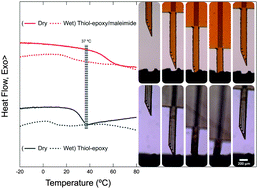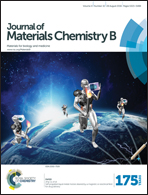Thiol–epoxy/maleimide ternary networks as softening substrates for flexible electronics†
Abstract
Softening microelectrode arrays, or flexible bioelectronic systems which can dynamically change modulus under the application of an external stimulus such as heat or electromagnetic radiation, have been of significant interest in the literature within the previous decade. Through their ability to actively soften in vivo, these devices have shown the capacity to attenuate the neuronal damage associated with insertion of rigid microelectrode arrays into soft tissue. Thiol-click substrates specifically have shown particularly impressive results for fabricating devices requiring small-scale, high-performance electronics for neural recording. However, previous attempts to engineer increasingly lower-modulus substrates for these devices have failed due to the fundamental chemistries' (the thioether linkage) flexibility. This failure has led to substrates without sufficient mechanical rigidity for penetrating soft tissue at physiological temperatures, or sufficient softening capacity to reduce the mechanical mismatch between soft tissue and implantable device. In this work, a ternary thiol–epoxy/maleimide network is investigated as a potential substrate materials space in which the degree of softening can be modulated without sacrificing the mechanical rigidity at physiological temperatures. Using these networks as platforms for the microfabrication of electrode arrays, example implantable intracortical microelectrode arrays are fabricated on both thiol–epoxy and thiol–epoxy/maleimide networks to demonstrate the insertion capacity of microelectrode arrays on the ternary polymer networks.


 Please wait while we load your content...
Please wait while we load your content...